Spotify Technology SA announced on Monday that it will raise premium subscription prices across multiple international markets, a move that pushed its shares up as much as 7.88%.
The Swedish streaming giant is updating prices in regions including South Asia, the Middle East, Africa, Europe, Latin America, and the Asia-Pacific over the coming month.
The price adjustments follow a string of prior increases in select markets and come as Spotify looks to capitalize on strong demand and a loyal user base.
The company stated that customers will receive emails outlining the new pricing plans.
Though price changes will vary by country, a sample notice included in the announcement described a €1 increase, bringing the monthly subscription to €11.99 ($13.87).
Expanding global pricing strategy
Spotify has already implemented price increases in the United States, where it raised subscription fees twice last year to reach $11.99 per month.
According to the company, the new pricing strategy will be rolled out gradually across all affected regions, with customer notifications sent ahead of the changes.
The price hikes also reflect growing calls from investors and record labels for Spotify to better monetize its extensive user base.
Research by analytics firm Antenna has shown that Spotify listeners are among the least likely to cancel subscriptions compared to other streaming services, reinforcing the company’s pricing power.
In the latest earnings report, Spotify revealed its premium subscriber count rose by 12% year-over-year to 276 million users, citing “growth across all regions.”
Overall monthly active users reached 696 million. Despite this growth, the company reported a net loss for the quarter, primarily due to higher-than-expected expenses tied to employee compensation.
Balancing growth and profitability
The timing of the price increases comes on the heels of Spotify’s underwhelming quarterly results.
Executives acknowledged that the company is investing heavily in areas such as audiobooks, video content, and advertising infrastructure as it seeks to diversify revenue streams and improve long-term profitability.
Spotify introduced audiobooks as part of its premium offering earlier this year, marking a notable expansion beyond music streaming.
Meanwhile, executives maintain that the company’s pricing strategy is guided by long-term objectives.
Speaking to analysts last week, Chief Business Officer Alex Norström emphasized that Spotify adjusts prices “when it’s appropriate for the business.”
He added that the company “essentially raises prices all the time,” citing recent increases in France, Belgium, the Netherlands, and Luxembourg as examples of its dynamic pricing approach.
Investor reaction and outlook
Spotify shares have risen roughly 49% year-to-date, signaling investor confidence in the company’s broader strategy despite recent earnings volatility.
The latest market boost suggests that markets view the global price hike as a positive step toward improved margins and revenue growth.
While some users may be affected by the higher costs, Spotify’s deep integration into the daily habits of its listeners—many of whom have built years’ worth of curated playlists and audio libraries—gives the company a cushion against widespread churn.
With the latest changes, Spotify aims to strike a balance between expanding its services and ensuring long-term financial sustainability, even as it navigates a competitive and evolving streaming landscape.
The post Spotify shares jump 7% after hiking global subscription prices appeared first on Invezz



